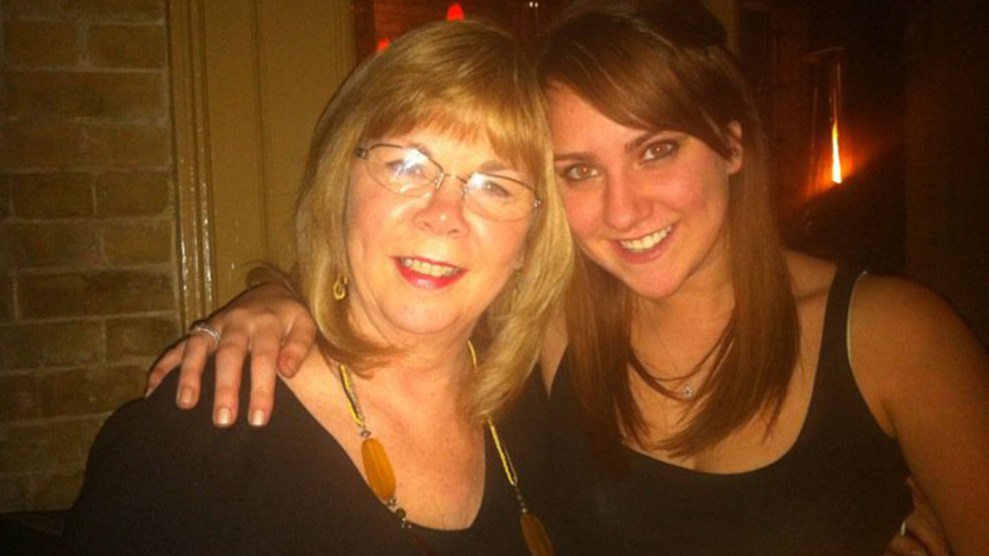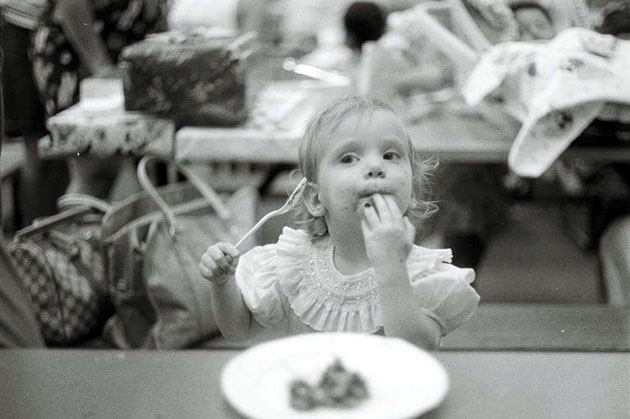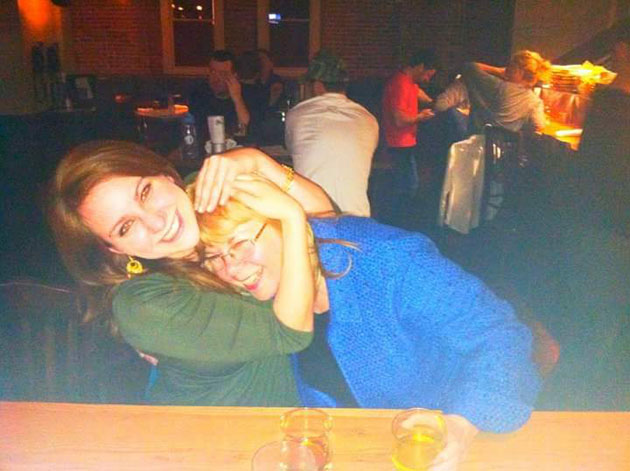
Sandy Phillips and her daughter, Jessi.
At 24 years old, my daughter, Jessi, was sparky, beautiful, and ambitious, with red hair that mirrored her fiery spirit. In summer 2012, she was finishing her final year of college in Colorado and looking forward to pursuing a career as a sports journalist. On the night before she had an interview for a dream job, she went with her close friend Brent to a midnight movie.
I was up late that night, unable to sleep, and texted her just to say hi. I was set to travel from our home in Texas the following week to help her furnish a new apartment.
“I can’t wait for you to come visit,” Jessi pinged back. “I need my mama.”
Less than an hour later, Brent called me from inside the theater in Aurora where they’d gone to see the premiere of The Dark Knight Rises. “There’s been a shooting,” he said, breathless. I could hear people screaming in the background.
“What are you telling me?” I asked. “Are you okay?”
“I’ve been hit. Twice, I think.”
“Where’s Jessi?” My heart was racing.
“I’m sorry,” he said.
When the gunfire had erupted inside the theater, Jessi and Brent leapt out of their chairs to flee. Jessi got shot in the leg. “I’ve been hit!” she yelled as she fell. “Someone call 911!” The bullets kept coming—bullets with the power and velocity to penetrate walls and seats, bodies and bones. She was hit five more times, including in her head. Brent stayed by her side. He got hit as well, with one bullet just missing his spleen. Jessi was one of 12 who died. Brent was among the 70 others who were wounded or injured in the attack.
I can’t remember the moments right after I realized Jessi was gone. My husband, Lonnie, later told me that he awoke to the sound of my screams and caught me as I crumpled to the floor. I recall little else from that night, except that my son, who is a paramedic, rushed over to the house and gave me some pills so I could calm down and eventually rest.
In the fog of those first few days, I was too distraught to really sleep, bathe, or think. We learned that two police officers had driven Jessi to the hospital after she was shot, with one holding her in the backseat. She was pronounced dead at 1:10 a.m. I felt a sense of relief that she didn’t die alone on the theater floor. I also remember feeling that I would never know happiness again. At one point, a friend suggested that it might be good to take a shower. Apparently I headed to the bathroom. As Lonnie tells it, he soon heard guttural howling. He rushed into the shower fully clothed and embraced me.
Less than two months earlier, Jessi had narrowly missed another shooting, at a mall in Toronto. Just a couple minutes after she and her boyfriend left the food court, a gunman opened fire, killing two people and wounding several others. I was working in the garden when Jessi called, her voice shaking. I reassured her. She went home and wrote on her blog, “Every second of every day is a gift.”

Jessi loved hockey; her green scarf accompanies Sandy on all trips to lobby lawmakers
It was five years ago today that Jessi was killed. On that day, I entered an inescapable nightmare. A fire also began to burn inside of me. The following morning, I told Lonnie, “We need to get involved.” He knew exactly what I meant. We knew that we needed to try to save other families from this unthinkable pain. What followed was a tumultuous journey we never could have anticipated. We were thrust into the media spotlight and the world of activism against gun violence. We came face to face with powerful political leaders, including President Obama. We spent four grueling months in a Denver courtroom, bearing witness to the trial of Jessi’s killer. This spring, we traveled to Congress to testify against President Donald Trump’s ardently pro-gun Supreme Court pick, Justice Neil Gorsuch.
There was one experience that showed us, more than any other, how warped America’s relationship with gun violence is. It came when we decided to sue the dealer that armed our daughter’s killer. The gunman bought more than 4,000 rounds of ammunition before his shooting spree—no background check, no questions asked. But a judge dismissed our case. Gun dealers are shielded by the Protection of Lawful Commerce in Arms Act, a controversial law that protects them from liability when crimes are committed with their products.
Worse, in accordance with the law, the judge ordered us to pay more than $200,000 in legal fees to the defendants. In part because of that ruling, Lonnie and I were forced this year to file for bankruptcy.
There are so many thoughts that haunt you when the worst happens. For weeks I thought about how Jessi almost ended up in an adjacent sold-out theater where no one was killed. I dwelled on the strangeness of the near-miss at the Toronto mall. I remembered how Jessi never liked the sound of fireworks; she thought they sounded like gunfire. I hated the fact that gunshots were the last sounds she heard.
Five months after Jessi’s funeral in Texas, which drew nearly 2,000 friends and supporters, Lonnie and I headed to Colorado to pick up Jessi’s diploma and speak at her university. We managed to joke that of course she would get her degree without having to take any final exams. As we boarded the plane, we heard about the breaking news: A gunman had attacked Sandy Hook Elementary School in Newtown, Connecticut. By the time we landed in Colorado, people were checking their phones, talking in hushed, stunned voices about 20 dead children. Lonnie and I were sitting near the back of the plane. I lost it. “Shut up! Stop talking about it!” I screamed. Lonnie tried to console me.
In Colorado, we met with leaders from a major gun violence prevention group, now known as Everytown for Gun Safety. They invited us to New York City to speak at a press conference with Mayor Michael Bloomberg. We met other survivors, each with their own devastating story. Then the Brady Campaign to Prevent Gun Violence invited us to a meeting at the Obama White House with senior adviser Valerie Jarrett. We had already battled to try to get the Cinemark theater in Aurora to create a memorial in honor of the lives lost—the theater refused—but now we were entering a much broader arena.
My husband and I respect the Second Amendment. We are longtime gun owners, who for 30 years made our home in Texas. We have no interest in taking away everyone’s guns, as the National Rifle Association and other fearmongers like to claim. However, we believe our nation’s laws can be vastly improved to save lives. Like most Americans, we want to see background checks on all gun sales. We want to see loopholes closed. We want to see limits on the type of gun and the amount of ammunition that can be sold to an individual.
We traveled on to Newtown to try to help. At a gathering for the survivors and their families, we held people’s hands. We knew they would not remember us in their state of shock, but we wanted them to know that they were not alone, that it was possible to survive unimaginable grief. They were now part of the same awful family that no one wants to belong to.

Jessi at her brother’s 3rd birthday party
In spring 2013, now working with the Brady Campaign, Lonnie and I met President Obama at a roundtable event with law enforcement officials and community leaders in Denver. He gave us both a hug, then sat down next to me at the table. Turning to me, he said, “First of all, I am so sorry for your loss. I realize that what happened to your daughter could have happened to one of mine.” Then he asked me why I thought Americans were so bitterly divided over gun politics. I was taken aback. “Mr. President, I think you would know the answer to that better than me,” I managed to quip. That lightened up the mood a little; a few people chuckled. I said that Americans were working hard, putting in long hours, then coming home, feeding their families, and falling into bed. They didn’t have much time for politics. They were just trying to make ends meet.
Working for the Brady Campaign became a flurry of media appearances and meetings with politicians, police, and survivors. The Brady leadership also encouraged Lonnie and me to sue Lucky Gunner, the dealer that sold the stockpile of ammo to Jessi’s killer. We agreed that dealers should have to take some responsibility. Shouldn’t they have to vet a buyer of military-grade weaponry? Or a buyer of bullets en masse? The primary goal of our lawsuit was to make the gun dealer change its business practices—at a minimum, to ask for proof of identity and do a background check.
The case would go on for three months, yet we never met the judge and never saw a courtroom. When the judge dismissed the suit, he said, “It is apparent that this case was filed to pursue the political purposes of the Brady Center.” In my opinion, the law that protects the gun dealers also bars people like us from our constitutional right to be heard.
Lonnie and I knew we had to be there when the trial for Jessi’s killer began in Denver in spring 2015. We needed to face him. But you will not hear me say his name. When a mass shooting occurs, the news media go overboard devoting attention to the killer’s past, his family, his manifesto. It’s what the killer wants. And research has shown that it helps inspire the next killer to seek similar fame.
Money was tight and we knew the trial would be long. We decided to sell our home and most of what we owned, and we bought a travel camper. We would drive it up from Texas and live in it while attending the trial and then use it to continue around the country, advocating for change.
During the trial, Lonnie and I finally gathered the courage to look at Jessi’s autopsy report. We agreed that we would not look at the pictures but would read the words. I needed to be able to speak the truth of what happened to her in that theater.
She was hit by a total of six bullets. In addition to the leg wound, she was shot three times in the abdomen. Another round struck her in the shoulder, shattering her clavicle. The bullet that entered through Jessi’s eye left a five-inch hole in the back of her head, blowing her brains onto the theater seats, floor, and people around her.
After the killer was sentenced to life in prison without parole, Lonnie and I continued on the road, scraping by. Sometimes friends would let us stay with them for a spell, or a church or group would raise funds for us. We have met victims of mass shootings all over the country, including in Charleston, South Carolina; San Bernardino, California; and Orlando, Florida, where 49 people were massacred at the Pulse nightclub—the deadliest mass shooting in modern US history. We have become close friends with the family of Alison Parker, the young television news reporter who was gunned down live on the air along with a colleague while broadcasting in Roanoke, Virginia.
On the night of the presidential election last November, we were invited to what was supposed to be a big victory party for Hillary Clinton in New York City. We watched in dismay as the election results came in. Donald Trump had bragged that he could shoot somebody in the middle of Fifth Avenue and people would still love him. He’d suggested that guns should be allowed in nightclubs like Pulse, so that people could shoot back if someone started firing. He’d insinuated during the campaign that Clinton herself might be shot if she dispensed with her armed security detail. With Trump’s election, we knew our battle for gun safety would only grow in difficulty and importance.
Trump is a demonstrated fan of Alex Jones, the conspiracy theorist who suggests to millions of listeners that mass shootings are orchestrated by the government to promote gun control. He and other self-styled “truthers” harass the families of victims, also spinning insane theories that mass shootings such as Sandy Hook are fake, that the victims were played by actors.
Truthers—or “hoaxers,” as they should be called—have defamed my daughter on blog after blog, saying she is a liar and a fraud. They claim Jessi is alive, secretly living it up on an exotic island somewhere. One time in San Antonio, at an event for the advocacy group Moms Demand Action for Gun Sense in America, Jones accosted Lonnie and me, accusing us of working for the government. Jones had just come from an “open carry” gun rally across town, where he’d worn an assault rifle strapped across his back. Video of the encounter shows how he tried to physically menace Lonnie, poking a finger at his chest and suggesting that he didn’t want to “beat an old guy up.”
Later, Jones posted the video on his InfoWars site and called us “idiots.”
It’s the little things you miss the most. I’ll see a mother and daughter in a restaurant, or taking a trip together at the airport, and then it floods me. I miss Jessi’s sass, the flash in her eye. I miss her texting me pictures of her trying on clothes, asking me what I think of this outfit or that. I miss her telling me, “I just had my hair cut. What do you think?” I miss the way she laughed—she was not a giggler, she was a belly laugher. She would throw her head back and a burst of pure joy would come out.
People say many things to try to help with the grief. A scientist once told me, “All we are is energy. Energy never dies. It continues on. It just changes form.” I like to think of Jessi that way sometimes. Recently, a young medical student approached me after a film event. She said, “When you carry a child, the DNA flows back and forth in the fluids between mother and child. Jessi will always physically be a part of you.” I found solace in that, too.

Jessi at 22, on a girls’ night out for Sandy’s 60th birthday
Today, after nearly five years of activism, Lonnie and I continue to struggle. We filed for Chapter 11 protection in January because we could not afford to pay the legal fees for Lucky Gunner.
But even if we could afford the gun dealer’s legal fees, we would never pay.
Nor will we stop our fight for change. We are among the vast majority of Americans who believe that we must take sensible steps to prevent massacres like the one that took my daughter’s life. We will continue to speak up. We will not go away.
All photos courtesy of the Phillips family.















